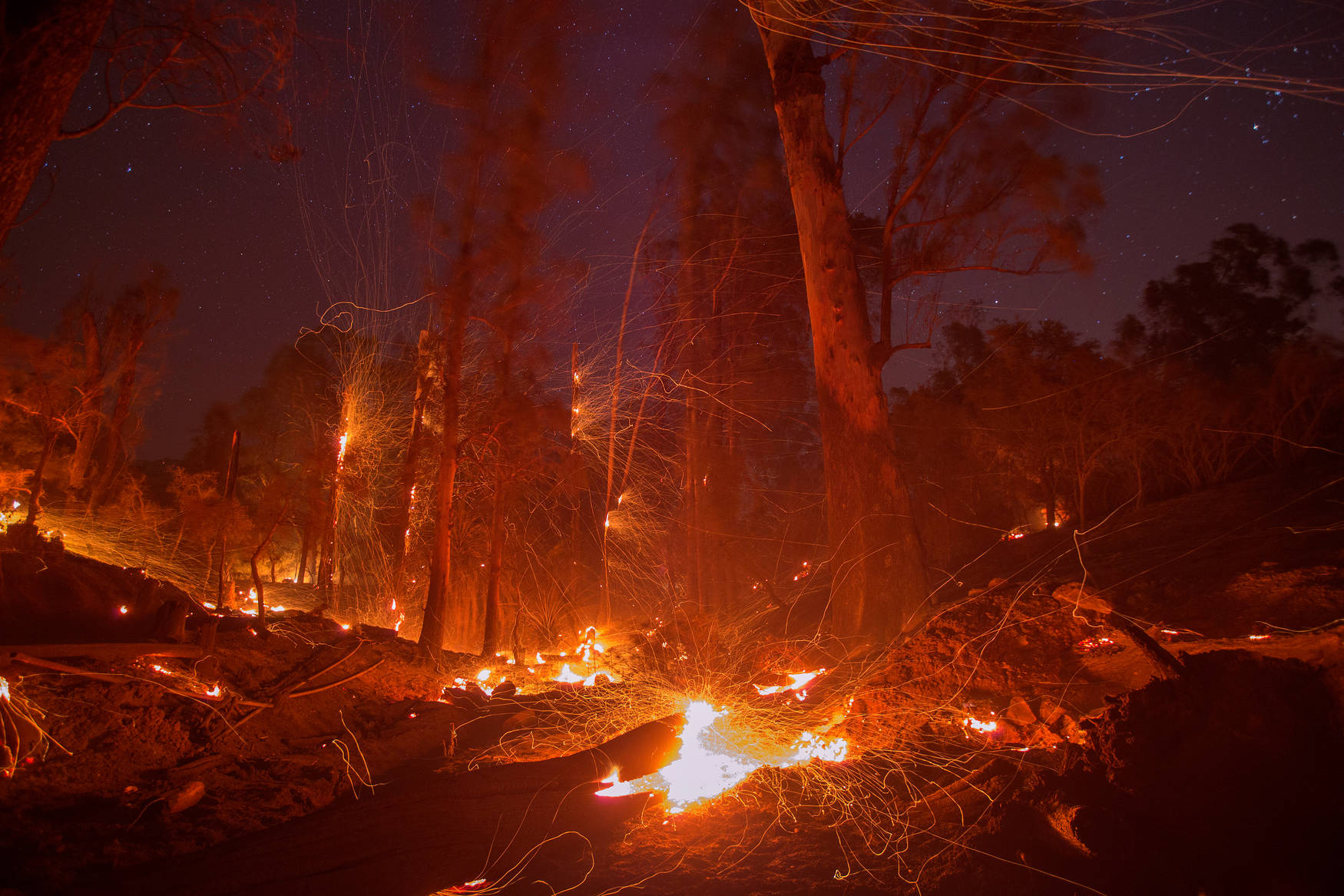Our Wildfire Evacuation, Part 2
from Survival Blog:

(Continued from Part 1.)
So we put this plan together on paper, that’s all that we needed to do, right? Um, no. Practicing an evacuation drill is probably at least as important as having an evacuation plan. After I had revised our plan into the checklist format, I knew that we needed to practice it to see if the timeframes were correct (i.e., could we actually do all the stuff that I’d written down on the 1-minute checklist in 1 minute?). Shortly after the Tubbs Fire (in October, 2017) we did a walk-through of the house and pointed out all the items on the checklist and where they were located. We planned to do a dry run on November 5th – but something came up and we had to postpone it… We never did get the chance to do that dry run before we had to “do it live.”
Of course it goes without saying that this is my checklist – it (mostly) works for me and my family, and it’s always undergoing tweaks and revisions as new items get added, as things get moved around for better storage, or if my wife (henceforth, “W.” in this article) has a better idea than one of mine. Should you decide that a checklist could work for you, yours will likely be different (and may be very different) from mine. That’s great – customizing any plan to fit your family’s needs is exactly what is should happen; just like my dissatisfaction with the “generic emergency-fair” list is what prompted me to make one that was a better fit for us.
So that’s the story of how our checklists were supposed to work out. How did we do during the actual evacuation?
EVACUATION
NOTE – Much of this portion was written just after the fire while we were still displaced from our house and while it was still fresh in my mind. I’ve edited it a bit to change the tone from present tense to past tense, but left it pretty much as I originally wrote it. I had planned to submit this to SurvivalBlog quite some time ago, but never felt it conveyed all that I wanted to say – even though it may not say all that I want, I do hope that it might be of some help to someone.
Monday 12/04/17
~9:35pm
The power went out in our area and my wife (“W.”) was next door at her monthly book-club shindig. I went outside to take a flashlight to her and noticed the sky just north of us was filled with smoke – this was the first warning I had of fire in area. It was so windy that everything was blowing over the top of us – no ash, no smoke, and no telltale smell, just a black wall next to the full moon.
I have to admit, normalcy-bias set in hard: I kept looking at the smoke saying, “that’s got to be a cloud or fog, because if it’s smoke, we’re totally screwed. I’ve never seen clouds like that, but it can’t be smoke, there’s no ash…” This went on for a good 15 seconds as I walked down the street until I realized that, “Yep, it’s smoke; and yep, we’re totally screwed.” I warned the neighbors, grabbed W., and we went back home to set our plans in motion.
No radio stations were providing any information; the local AM “emergency” station was off air and the local FM “emergency” station was still playing Christmas music. My WeatherAlert radio was just talking about the strong winds, nothing about any fires developing.
We grabbed our GO bags and our evacuation checklist, and placed them in the garage – which is our pre-designated staging area. We put harnesses on both pets and put each in separate bathrooms (so they couldn’t run off and hide under the bed).
~10:00pm
Those tasks completed, there was still no info available (power was out [no Internet], nothing on the radio, my phone’s emergency-scanner app was not updated on my “new phone”, it was on my old phone), so with no source of information, W. wanted to find out if we could determine how close the fire was. We drove a mile up the street and saw the 1st glow of fire over the NE hills – we drove back around to our home, and in the ~4 minutes this trip took for us, the fire had moved in and we saw a nearly 180° glow from east to NW around us.
We got home and used the checklist to grab all the items off our 1-minute list, put the pets into their carriers, and then re-evaluated situation. We decided we had time for more items, so we started on our 5-minute and then 15-minute checklists – we gathered and loaded items while re-evaluating the situation with each load brought out. During this time, I connected our small travel trailer to my truck and we also began loading items into it.
Having headlamp-flashlights (hands-free lighting) was a HUGE help during this time – so much so that I actually commented on it to W. in the middle of everything else that was going on. I don’t even want to think about trying to do all the stuff we had to with having only one hand free.
~10:20pm
Our elderly neighbor came over and told us he couldn’t figure out how to get his garage open without power (you know, pull on the release cord to disengage the opener) – W., who was carrying the yowling pets out to the car, told him how to do it and said she could come over in a few minutes to show him, if needed. He got it figured out quickly and was able to drive away.
Cars were now just starting to evacuate the neighborhood and police were coming up and down the streets using their PA systems to announce mandatory evacuations.
~10:30pm
We’d added nearly all of the stuff from our 5-minute checklist and most from our 15-minute checklist when we decided, “it’s time to go.” We locked up the house and garage and took both vehicles as we left. W. was in her car with the pets and she blocked off traffic so I could pull out with the trailer.
10:37pm
We had evacuated from our home – and we sat in traffic that was not moving. We were not on a major street – our street only serves our neighborhood, so I couldn’t understand why we were not moving. On a side note, it’s a rotten feeling to look back at your abandoned house thinking that you’re probably not going to see it again. We then sat in front of our house for nearly an hour, as the traffic slowly unsnarled, watching the glow of the fire get closer and brighter.
11:30pm
Traffic finally started moving – Police were finally directing traffic at the entrance to our neighborhood which allowed us to finally move. I later heard that a serious traffic accident had held up the evacuation this whole time.
It was at this time that the fire came over the last ridge and moved into our neighborhood.
11:37pm
We got out of the neighborhood and I looked back towards the hills where our house is. ALL of the hills had visible flames on them.
12:02am
We arrived at our friend’s house, who offered shelter to us (one of our pre-designated evacuation points). I stayed up all night in the trailer, watching the fire to see if we would need to evacuate again.
We later learned that the fire was advancing one mile per minute, at times.
LESSONS LEARNED OR THINGS THAT WORKED OK:
- Stay aware
- I hadn’t heard anything about the fire in nearby Santa Paula – if I hadn’t gone outside when the power went out, we would have lost much of our prep-time.
- Unfortunately, you can’t always count on prompt notification and I’ve already mentioned the problems with the local radio stations. I later found out that the fire started ~6:45pm, and by 7:30, one local fire captain claimed that this was a “career event”; but, we never got notification via reverse-911 or Emergency alert texts until 10:45, when we were already out of the house. Man, when I think of what we could have done with that extra time… This lack of prompt information / notification is still a VERY sore subject with me to this day.
- Think for yourself – if things aren’t looking good, don’t wait for someone to tell you to leave. We would have lost most of our prep time if we had waited for the mandatory order.
- Have a plan. Know: 1) what event(s) will cause you to “go now”, 2) where you will go, 3) when you will go, 4) what will you take, 5) who will do which of the necessary task(s), etc.
- Write down your plan – ours is in the form of a time-sensitive checklist, yours should be in whatever format works best for you.
- Practice your plan – as mentioned, we’d planned to do a timed test on a Sunday 4 weeks before the fire, but something came up and we had to postpone it… Since, at this point, our list was still just “theoretical”, this resulted in some unrealistic time-frames in our checklist. As you can see from the evacuation timeframe above, we had nearly 30 minutes from when we returned from our “recon” until we left, but we were only able to grab the 1, 5, and most of the 15 minute items – even though we knew where all the stuff was. If we’d been able to practice our plan, we would have realized that I was too optimistic when I put the checklists together and that some of the items were not appropriate to this current situation, which resulted in some confusion and lost time – more on this in a later post.
- Have 1 or 2 pre-designated friends / family-members where you can evacuate to – preferably in different directions as you don’t know which direction you may need to travel. You can reciprocate the favor and also be their evacuation point.
Loading...



